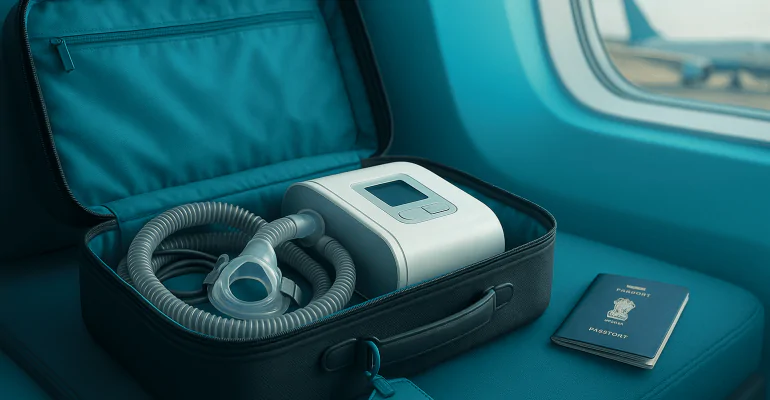Can a CPAP machine be carried on airlines in India & internationally?
October 24, 2025 2025-10-24 10:44Can a CPAP machine be carried on airlines in India & internationally?

Can a CPAP machine be carried on airlines in India & internationally?
Yes, you can bring a CPAP machine with you on flights within India and to other countries. Most airlines see CPAP as a medical or assistive device, and some, like IndiGo, don’t count it against your cabin baggage limit when it’s in its bag.
Some airlines want to know ahead of time if you plan to use it on a flight, and you may need to follow screening and battery rules.
What Indian airlines say
IndiGo: Lists CPAP as an “Assistive Device” and says that assistive devices don’t count towards your carry-on or checked baggage limits (but they still have to follow size, weight, and safety rules).
Air India: Allows CPAP/POC devices that have been approved by the FAA and EASA. If you plan to use the device on board, make sure you have enough battery life for 150% of the flight time (in-seat power isn’t guaranteed). You might need to get medical clearance, depending on your condition.
SpiceJet: You can bring a CPAP or BiPAP on board as long as you get security clearance. If you use it on the plane, ensure that you bring batteries that last 150% of the flight.
(Always check with your airline before you fly to see if their rules have changed.)
Power and batteries (what most people get wrong)
Lithium battery basics: You can’t put spare lithium batteries or power banks in your checked bags; they have to stay in your cabin. Most of the time, you can bring batteries with less than 100 Wh.
Batteries with 101 to 160 Wh usually need airline approval, and batteries with more than that usually aren’t allowed. Keep spare parts safe from short circuits by keeping them separate.
Using it on the plane: If you plan to use your CPAP while flying, many airlines require you to bring enough batteries to last 150% of the scheduled flight time (to cover any delays). Don’t depend on the power in your seat.
Give them a heads up: A lot of airlines want you to let them know ahead of time (48 hours to two weeks) if you plan to use a CPAP on board. This helps them seat you near a power outlet if one is available and note any special needs.
Screening at the airport
At security, they will usually ask you to take the CPAP unit out of its case so it can be X-rayed. The tubing and mask can usually stay in the bag.
It’s normal and safe for the machine for officers to swab it for explosives. If you want to bring distilled water for a humidifier, buy it after going through security or put it in containers that follow the rules for liquids.
Having a short note from your doctor or a prescription can help with questions, but it’s not always necessary.
Your rights and what changes when you fly internationally
Disability laws protect your right to bring an assistive device like a CPAP along with your regular carry-on on many international flights, especially those to and from the U.S. The U.S. DOT’s rules say that assistive devices don’t count towards baggage limits, as long as the bag isn’t used to carry personal items.
However, airlines may have different rules about using power outlets and getting medical help on board. Check the airline’s medical/accessible travel page for more information.
Quick pictures of airlines as of October 2025
IndiGo (India): A CPAP machine is an assistive device and doesn’t count towards your baggage limit if you carry it separately.
Air India (India and international): CPAP is allowed, but you should have 150% battery life for use on the plane. You may need medical clearance.
SpiceJet (India): Allowed with security clearance; 150% battery if used on a flight.
Emirates (an international example): CPAP machines are allowed, but lithium battery rules are strict. Spare batteries can only be kept in the cabin, and power banks can’t be used or charged on board.
List of things to pack and get ready for India
1. Put it in a separate bag with the words “medical/assistive device” on it (many airlines won’t count it towards your allowance).
2. If you plan to use a CPAP machine on board, bring enough batteries (and extras) for 150% of the total flight time. Only keep spare lithium batteries in your cabin bag.
3. Print out the approval information for your device (FAA/EASA/in-flight use statement) and keep a copy of your doctor’s note or prescription.
4. When asked, take the device out of its case at security. The tubing and mask can usually stay in the bag.
5. If you need help with your seat or will use CPAP in the cabin, call the airline 48 hours to 2 weeks ahead of time.
The bottom line for Indian travellers is that they can usually bring their CPAP with them to India and other countries as an extra medical item. The most important things are the batteries (150% rule) and whether the airline needs to know ahead of time that you want to use them on the plane. A few days before you leave, check your carrier’s page and you’ll be fine.






